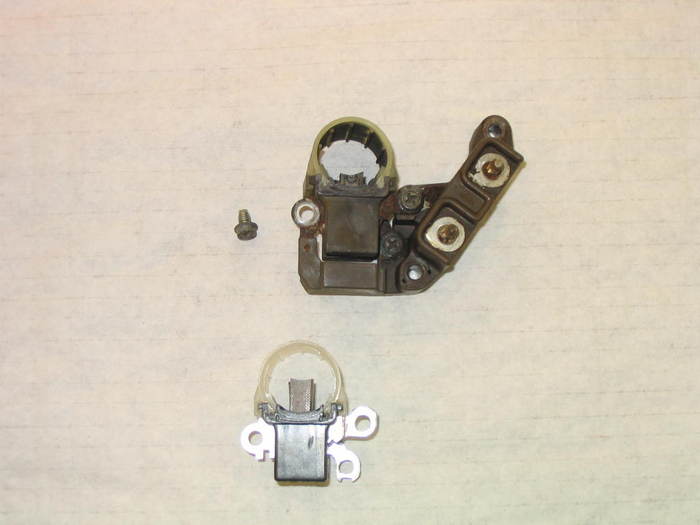Here's what the brush assembly looks like if you're going to replace it. The part in the upper right of the photo doesn't have to come off. I took it off because this is part of a set of instructions I put together for other instructors to build "bugged" cars for their students to troubleshoot. You can just take the three screws off that hold the white brush assembly on to that terminal block. Notice how much longer the new brushes are in the bottom assembly than in the top one.
I don't know if you can buy the brushes from NAPA or Carquest or the dealer. The Chrysler dealer's parts department used to sell the older style individual brushes real cheap. I get these assemblies from a local rebuilder. I can include a few more photos if needed. Otherwise, just replace the entire alternator.
You might also look in the salvage yards. I make a trip every year to a real nice chain of yards called "Pull-A-Part". They're in the Indiana, Kentucky, Tennessee, Georgia, Alabama area. Very clean and well organized. Pay your buck, throw your tool box into one of their wheel barrows, and spend all day if you want to. Parts are real inexpensive and people are friendly. This would be a nice place to take an alternator apart before repairing your own.
Encinasr, I didn't expect you to find the green wire down to just one volt. I suspect that might be due to the worn brushes just barely making contact. It would be interesting to hear what you find after the repair. I've never found less than four volts, and that's when the system was working real hard. Ten to eleven volts is more common when the battery is fully charged. The point is you caught it with 0 volts when it wasn't working. Dandy.
Kenbar1769, the rpm jumping, if it's about 200 rpm, is the torque converter unlocking and relocking for better fuel mileage. It locks up above about 40 mph when the engine is warmed up, and in third or overdrive. It will unlock if you tap the brake pedal or if the gas pedal is fully released or goes to near wide-open-throttle. It unlocks with the brake pedal in preparation for coming to a stop. This would be the same as pushing in the clutch pedal on a manual transmission so it doesn't snub the engine off when stopping the car. It unlocks at wide-open-throttle because a torque converter, by its very nature, doubles engine torque. The trade-off is reduced fuel mileage compared to a manual transmission's clutch. Once the extra torque isn't needed, and you let off the gas a little, it will relock and you'll see the tach. Drop about 200 rpm.
The first thing to try when the rpm is jumping around is to hold the brake pedal up with your foot. If the problem stops, suspect the brake light switch is out of adjustment. If that doesn't help, note if rpm drops a few seconds after you push the gas pedal a little closer to the floor, say to raise vehicle speed 5 - 10 mph. If it does, suspect a dirty spot on the throttle position sensor They typically are replaced, not repaired. You might be able to see "dropouts" while watching "live sensor data" on a scanner. You can also measure the voltage on the center wire with a voltmeter, but you have to move the throttle very slowly. The dropouts are real easy to miss by eye. The Engine Computer sees them and interprets them as you letting off the gas pedal. The torque converter unlocks when you fully release the gas pedal so the car will coast better, again, for better fuel mileage. What you should see with the voltmeter is one wire will have 0.2 volts, one will have 5.0 volts, and the one you're after will have close to 0.5 volts. That one will increase steadily to close to 4.5 volts as you open the throttle. You're looking for any point where the voltage pops up to 5.0 volts or 0.0 volts. That can happen very quickly. The best chance you'll have of seeing it is if you take about 30 seconds to go from idle to wide-open-throttle. If you do see a dropout, replace the sensor. If you don't see a dropout, you might consider just replacing it as a test. We don't like to throw parts at a problem, but sometimes that's what it comes down to.
Another approach is to connect a scanner with a record / playback feature and take it on a test drive. I use the Chrysler DRB3. You press the "record" button when the problem occurs, then you can replay the series of events later to look for a glitch in one of the sensor readings. Because the sensor data passes through the scanner's memory, the recording actually begins a few seconds before you pressed the record button.
Caradiodoc
Image (Click to make bigger)
Thursday, January 27th, 2011 AT 8:36 PM



